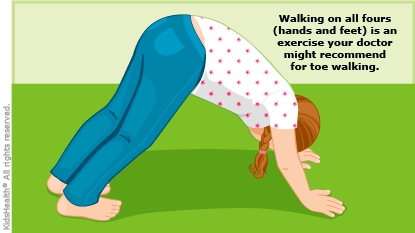What Is Toe Walking?
Toe walking is when kids walk on the balls of their feet, with their heels off the ground. It’s common in toddlers as they learn to walk. Most children stop toe walking on their own by age 2.
What Causes Toe Walking?
Kids might toe walk because:
- They’re learning to walk.
- They have tight calf muscles.
- Their Achilles tendon is tight.
- They have neurologic disorder (such as cerebral palsy or autism).
- They have muscular dystrophy, which damages muscles.
Sometimes the reason for toe walking is not known.
What Problems Can Toe Walking Cause?
Toe walking can make a child more likely to fall. A child might feel self-conscious about walking differently from other kids.
How Do Doctors Diagnose Toe Walking?
Doctors diagnose toe walking by asking questions and doing an exam. If needed, they might do other tests, such as:
- an EMG to look at how the muscles and nerves work
- a gait analysis to check movements during walking
- neurologic testing to see if there are problems with how the brain and spinal cord work or developmental delays
Children with toe walking may need to see an orthopedic doctor (a doctor who treats problems affecting bones and joints).
How Do Doctors Treat Toe Walking?
Many young children outgrow toe walking. So doctors might wait to see how the child does without treatment.
If the toe walking continues, or if the child has a physical reason for toe walking (such as tight muscles or tendons), treatment may include:
- physical therapy
- leg braces or splints
- casting
- surgery
When Should I Call the Doctor?
Call your doctor if:
- Your child is over 2 years old and still toe walks.
- Your child was walking normally and then starts to toe walk.
- Your child toe walks and you have concerns about their development.
How Can Parents Help?
If your child is toe walking, help them follow the doctor’s instructions. If your child is under age 2, your doctor may recommend coming back in a few months to check to see if the toe walking is getting better.
If recommended, help your child:
- Do stretching or strengthening exercises.
- Go to physical therapy.
- See an orthopedic specialist.
- Wear leg braces or splints.



